Sandmann
Well-known member
Dear fellow collectors,
I’m very happy to present you the latest addition to my collection. It is a beautiful M1860 enlisted men's helmet of the Dragoon Regiment „König“ (2nd Wurttemberg) No. 26 from Cannstatt (Stuttgart), which came into service in 1879, according to the stamps. Unfortunately, the screw-on spike is missing, but the parade plume is in good condition, as is the rest.
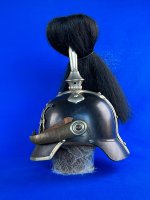
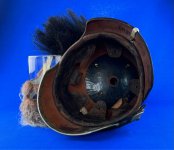
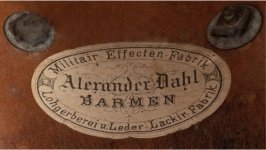
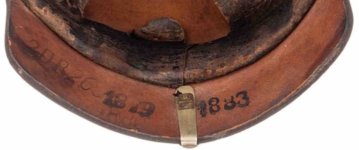
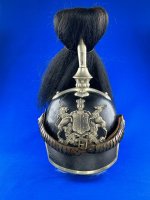
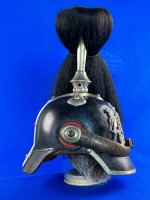
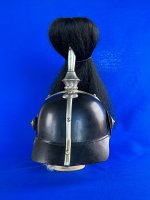
I’m very happy to present you the latest addition to my collection. It is a beautiful M1860 enlisted men's helmet of the Dragoon Regiment „König“ (2nd Wurttemberg) No. 26 from Cannstatt (Stuttgart), which came into service in 1879, according to the stamps. Unfortunately, the screw-on spike is missing, but the parade plume is in good condition, as is the rest.
- Interesting are the dimensions of the leather body, because it seems that the shell was made with the proportions of an M71, although according to the regulations the dragoons still wore the M60 helmet until 1894, when the M91 rosettes were introduced for cavalry units. The helmet shell is only 11.0 cm high and the helmet visors are very narrow either. With a front visor of 5.2 cm and a rear visor of 5.1 cm, they could be within the expected range of an M60 and M71, but while they would be in the lowest range for an M60, their width is fully within the expected range for an M71.

- The leather lining has 9 round flaps, which could pulled through with the missing leather cord, so that the fit of the helmet could be adjusted somewhat.

- The helmet has a beautiful makers label and was made from the military insignia company „Alexander Dahl“ in Barmen.

- On the rear visor is stamped in black ink "2DR26 1879 1880 1883". I think it means that the helmet was firstly proofed in 1879 and handed out to the 2nd escadron of the dragoon regiment no. 26. Then it was checked again by the clothing department in 1880 and 1883. But the „2DR26“ could also mean „2nd Wurtt. dragoon regiment no. 26“, I’m not sure about that. There was another stamp in the area of the „26“, but I can’t read it anymore. Just a ghost of a “3“ or „8“ is visible between the „26“ and the „1879“. Anyway, since the dimensional deviations to the M60 were not noticed, the clothing department probably only checked the general condition of use, i.e. whether the helmet had to be repaired in any way before its next output.

- The Wurttemberg plate is smaller than the Prussian eagle. It is only 11.0 cm high and 12.0 cm wide. At that time, it didn't have a star of the Order of the Wurttemberg Crown in nickel silver on the plate, this was awarded not before 5.12.1905 by AKO.

- The cross fitting is fixed with steel half-round head screws and squared brass bow nuts, while the plate is fixed with square nuts without bow.
- The brass curved chin scales are 3.5 cm wide at the back and 1,6 cm at the front (measured at the widest point at the back and at the level of the hook/eye attachment at the front). The oval silver rosettes measure 3.2 cm x 3.7 cm and the iron screw/threaded bush attachment is in accordance with the regulations up to 1894. On 18.5.1894 the M91 rosette was introduced in Prussia for cavalry units and for Wurttemberg it will have been at a similar time.
- The 65 mm Wurttemberg cockade is attached on the correct side and corresponds to the regulations. As known, the imperial cockade was introduced not before 1897.

- The silver funnel with the black hair plume has a height of 11 cm (+0.7 cm thread). This varied, because only the length of the hair was prescribed with 30 cm. This should end at the height of the upper edge of the front visor for enlisted men. For officers the hair should end only at the height of the lower edge of the front visor.

Last edited:
